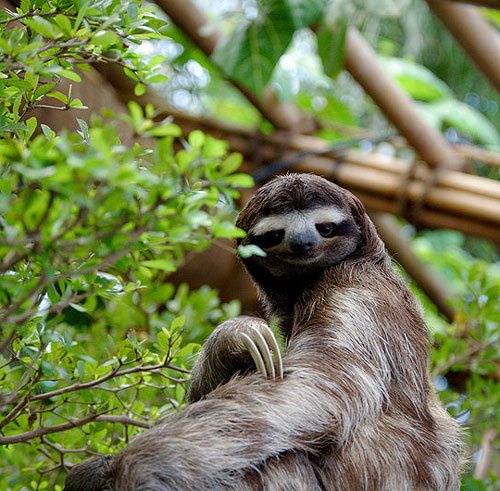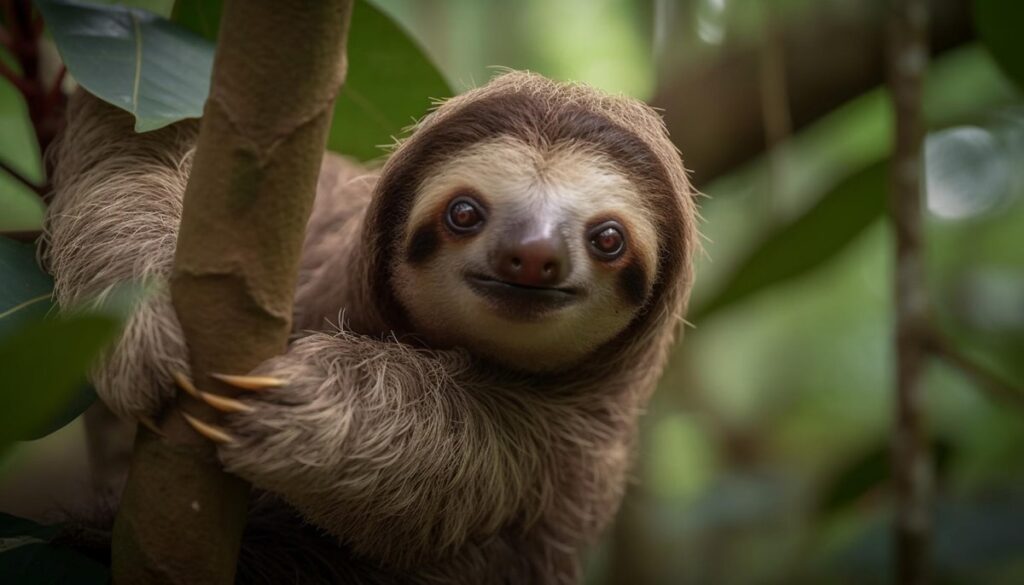1. Upside down: Sloths spend almost all their time in the trees and do everything upside down; sleeping, eating, mating, giving birth and feeding their young – all thanks to their claws
2. Dead sloths: Dead sloths can remain hanging (upside down) from a branch despite being dead
3. Giant ancestor: The ancestor of sloths was the giant sloth Megatherium, which at its time (around 10,000 years ago) was only surpassed in size by a few mammoth species. They could weigh up to 4 tons and measure 6 meters from tail to head
4. Obesity: Sloths don’t get obese; all extra fat is apparently stored on the soles of their feet!
5. Hair growth: Sloths’ hair grows in the opposite direction to all other mammals; in mammals, the hair always grows towards the extremities, but because sloths hang upside down and legs up most of the day, the hair grows in the opposite direction, protecting them from precipitation and the like.

Fact: Sloths are antisocial animals that only come together to mate
6. Animals in the fur: Sloths are so passive that algae can grow in their fur. This algae gives sloths a slightly greenish color, which helps them camouflage themselves in the trees. In addition to algae, beetles and moths can also live in sloth fur
7. Speed: The usual speed for sloths on land is approximately 2 meters per minute. In cases where sloths feel threatened by predators, for example, they can move at up to 3-4 meters per minute on land and 4 meters per minute in the trees. However, they burn excessive amounts of energy at this level of activity
8. Sleep: In the past, sloths were thought to sleep 15-20 hours a day. However, it is now known that they sleep just under 10 hours per day. They generally spend most of their time eating and sleeping in trees
9. Ground contact: Sloths only climb down from the trees once a week! When they come down to the ground, it’s to defecate (and pee). They always dig a hole in the ground for their droppings, which they then cover up. By the way, they always defecate in the same place
10. Predator: Sloths are relatively vulnerable to predators because they 1) are slow, 2) always defecate in the same place, making them easy to track and 3) only have their claws and teeth to defend themselves. Their main enemies are jaguars and eagles
Other facts about sloths
- 2 or 3 toes: There are 6 species of sloths, but they are mostly divided into two-toed and three-toed sloths. Two-toed sloths spend more time hanging upside down than three-toed sloths
- Characteristics: Sloths have small heads with small eyes and ears. The rest of their body is relatively large and their long arms and legs are powerful, which helps them to climb trees
- As a pet: Sloths are not suitable as pets as they die quickly in captivity. However, they can survive in artificial environments, such as some zoos can provide
- Great swimmers: Sloths are clumsy and slow on land, but they are good swimmers and their fur allows them to move quickly in water. Sloths have been observed in several cases dropping directly from a tree into water (such as a lake or stream)
- Food: Sloths are leaf-eaters – i.e. herbivores that specialize in eating leaves. However, since leaves don’t contain much nutrition, sloths are equipped with large, slow-digesting stomachs that ensure all nutrients are absorbed from the leaves
- Energy: A sloth’s metabolism is very low and it can go for several days without eating or drinking. The low-energy diet, low metabolism, 10 hours of sleep and the sloth’s slow movement all help to maintain energy in the body
- Anti-social: Sloths are not social and only come together with other sloths to mate. A female sloth can give birth to a maximum of one baby per year
- Genes: Sloths are closely related to anteaters (in the order Pilosa) and a little more distantly to armadillos (in the superorder Gummers)
- Threats: However, the worst threats are poachers and electrical wires, as well as general human intrusion into sloth habitats
- Slowest animal: Sloths are well known for their title as the “slowest animal on earth”





